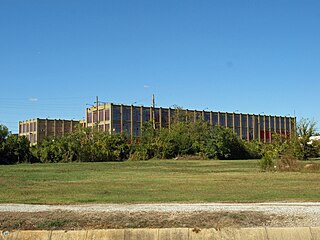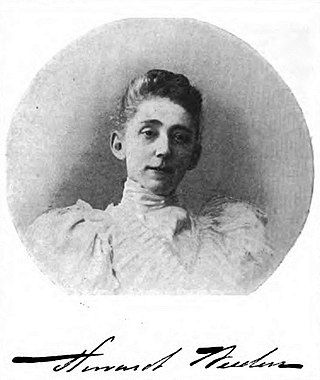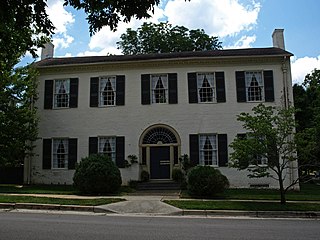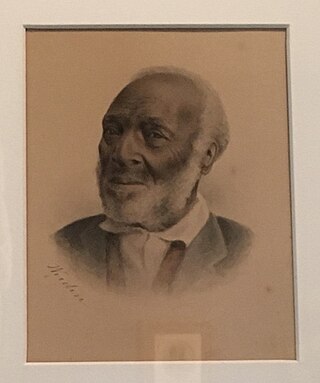
Huntsville is the most populous city in the U.S. state of Alabama. It is the county seat of Madison County with portions extending into Limestone County and Morgan County. It is located in the Appalachian region of northern Alabama.

St Margarets is an affluent suburb and neighbourhood in the London Borough of Richmond upon Thames, about 9 miles (14 km) west-southwest of central London. It is bounded by the Thames Tideway to the north-east, and the River Crane to the north-west and north where the land tapers between these rivers. Land and buildings closer to Richmond Bridge than the eponymous railway station are, traditionally distinctly, known as East Twickenham. Both places go by their post town and traditional parish, Twickenham quite often; in the 19th century the south of St Margarets was marked on maps as Twickenham Park.

Alabama Agricultural and Mechanical University is a public historically black land-grant university in Normal, Huntsville, Alabama. Founded in 1875, it took its present name in 1969. It was one of about 180 "normal schools" founded by state governments in the 19th century to train teachers for the rapidly growing public common schools. It was one of 23 established to train African Americans to teach in segregated schools. Some closed but most steadily expanded their role and became state colleges in the early 20th century and state universities in the late 20th century. AAMU is a member-school of the Thurgood Marshall College Fund and is accredited by the Southern Association of Colleges and Schools. Alabama Agricultural and Mechanical University Historic District, also known as Normal Hill College Historic District, has 28 buildings and four structures listed in the United States National Register of Historic Places.

Huntingdon College is a private Methodist college in Montgomery, Alabama. It was founded in 1854 as a women's college.

This is a list of the National Register of Historic Places listings in DeKalb County, Alabama.

The following properties are listed on the National Register of Historic Places in Madison County, Alabama.

The Old Town Historic District was the second historic district in Huntsville, Alabama. It was added to the National Register of Historic Places on July 18, 1978. Roughly bounded by Dement and Lincoln Sts., and Randolph and Walker Avenues, it features homes in a variety of styles including Victorian, Federal, Greek Revival, Queen Anne, American Craftsman, and even Prairie School with homes dating from the late 1820s through the early 20th century.

The Five Points Historic District is a historic district in Huntsville, Alabama in the vicinity and east of the intersection of Holmes Avenue, Pratt Avenue, California Street, and Andrew Jackson Way. It features homes built around the turn of the 20th Century in several styles, including California Bungalow, Queen Anne and other modest Victorian styles dating from the late 1890s through the early 1900s. The district was listed on the National Register of Historic Places in August 2012.

Dallas Mill was a manufacturer of cotton sheeting in Huntsville, Alabama, United States. The first of four major textile mills in Huntsville, the mill operated from 1891 until 1949, before it was converted for use as a warehouse in 1955 and burned in 1991. The village, constructed to house workers and their families, was incorporated into the city in 1955. The mill and its mill village are listed on the National Register of Historic Places.

Helion Lodge #1 is a Masonic lodge in Huntsville, Alabama. It is the oldest operating lodge of Freemasons in the state. According to Grand Historian Joseph Abram Jackson's Masonry in Alabama, it is "the birthplace of Freemasonry in Alabama." Helion Lodge is also the common name for the building, built in 1911, where the lodge meets.

The Lowry House is a historic home in Huntsville, Alabama. It was built circa 1850 by John Tate Lowry, a merchant with the firm of Lowry, Hamilton and Company. Elements of an earlier Lowry family log house, built circa 1809, that stood on the site were incorporated into the new construction.

104–128 South Side Square is a block of historic commercial buildings in Huntsville, Alabama, United States. The block, known as "Commercial Row" in the late 1800s, consists of fifteen two- and three-story buildings constructed between 1835 and 1912. 108, built in 1835 as a store for the Bell Factory textile mill, and 110, built in 1840, are the oldest buildings on the block but both have been extensively modified. 106, 112, 114, and 116 were all built in the 1880s in Italianate style; 118 was also built at this time but damaged by fire in 1901 and rebuilt without many of its original details. 128, built in 1896, is a transitional style between Italianate and the more restrained, 20th century Commercial Brick style. 104, 120, 122, and 124–126 were all built between 1903 and 1912 in the later commercial style. 122 was extensively renovated in 1965 with a modern façade. 124 and 126 have housed the Harrison Brothers hardware store since they were built in 1902; the store opened in another building on the square in 1897, and has been operated by the Historic Huntsville Foundation since 1984. At the time of the nomination, 100 had its original Italianate features covered or removed; it has since been restored, including a balcony wrapping around the façade and halfway down the Madison Street side of the building. The buildings were listed on the National Register of Historic Places in 1980.

The Lincoln Mill and Mill Village Historic District is a historic district in Huntsville, Alabama. Opened in 1900, it quickly grew to be Huntsville's largest cotton mill in the first quarter of the 20th century. After closing in 1955, the mills were converted to office space that was used by the U.S. space program. Two of the older production buildings burned in 1980, but one main building and numerous houses built for workers remain. The district was listed on the National Register of Historic Places in 2010.

Wessyngton is a historic mansion on a former tobacco plantation in Cedar Hill, Tennessee, U.S. It is listed on the National Register of Historic Places.

Maria Howard Weeden, who signed her work and published as Howard Weeden, was an American artist and poet based in Huntsville, Alabama. After the American Civil War, she began to sell works she painted, which included portraits of many African-American freedmen and freedwomen. She exhibited her work in Berlin and Paris in 1895, where it was well received. She published four books of her poetry from 1898 to 1904, illustrated with her own art. She was posthumously inducted into the Alabama Women's Hall of Fame in 1998.

The Weeden House Museum is a historic two-story house in Huntsville, Alabama. It was built in 1819 for Henry C. Bradford, and designed in the Federal architectural style. Until 1845, it was sold and purchased by several home owners, including John McKinley, who served as a Congressman, Senator, and Associate Justice of the Supreme Court of the United States. From 1845 to 1956, it belonged to the Weeden family. During the American Civil War of 1861-1865, the Union Army took over the house while the Weedens moved to Tuskegee; they moved back in after the war. Portraitist and poet Maria Howard Weeden spent most of her life in the house. After it was sold by the Weeden family in 1956, the house was remodelled into residential apartments. In 1973, it was purchased by the city of Huntsville and the Twickenham Historic Preservation District Association restored it before they acquired it from the city. The private residence became a house museum in 1981.
Frances Cabaniss Roberts was an American historian. She was a founding member of the University of Alabama in Huntsville who was posthumously inducted into the Alabama Women's Hall of Fame.

The Portrait of Saint Bartley Harris is a late-nineteenth-century watercolor portrait of Bartley Harris by Maria Howard Weeden, an artist from Huntsville, Alabama. Harris was the second known leader of what became the Saint Bartley Primitive Baptist Church.

James White McClung was an American lawyer and politician during the early days of Alabama statehood. He served in the Alabama state legislature between 1822 and 1844, was Speaker of the House from 1835–1838, and served in the state Senate from 1845–1849. At the time of his death he was a candidate for the United States Senate, without opposition. McClung Avenue in Hunstville is named for him, the first street in that city to be named after a local citizen.
Harvie P. Jones was an architect and author who worked to document and preserve historic buildings in Alabama. He was based in Huntsville, Alabama and was considered to be the city's best known architect. He was a partner at the firm Jones & Herrin Architects/Interior Design and did restoration work on historic buildings. The University of Alabama in Huntsville has a collection of his papers and photographs.






















